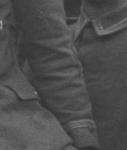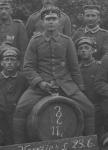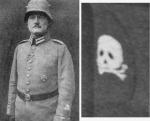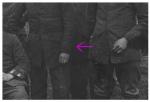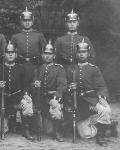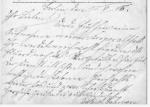
Thomas W
For Deletion-
Posts
788 -
Joined
-
Last visited
-
Days Won
3
Content Type
Profiles
Forums
Blogs
Gallery
Events
Store
Everything posted by Thomas W
-
Yeah, early photos show the Alpenkoprs men wearing their badges until it filtered down just how it should be worn. Every photo I've seen of Rohr's flamethrower men, all the way to the end of the war, shows the badge in the same position. Not only that, every man of Rohr's flamethrower platoon wore it in the same position. You argued earlier that maybe they all just started wearing it in the wrong positon and it stayed there, but now you're arguing that badges could be worn in the wrong position until official word filtered down. You just confirmed my deduction, that Rohr's men had special privileges to wear their badge in their own special position, because either they got it wrong and were then allowed to keep it wrong for the duration of the war (special privilege), or they were allowed to wear it in a different position from the beginning (special privilege). So, we agree. Rohr's men had special privileges.
-
Well, "Chrus," you can read it in all three of my books, for one. I assume you mean, "Which German order allowed Rohr's men to wear their badges in a position higher than that specified by the Kaiser's order"? No idea. See, most of the records of the German imperial army were destroyed in World War II. So, what I did was examine the dozens of photos I've seen, and they were all consistent--meaning, never once did I see a member of Rohr's flamethrower platoon wearing his badge in the position used by the men in Reddemann's unit. What I did was make a deduction based on physical evidence and reasoning. There are no orders stating that the Rohr Flamethrower platoon could wear a "5" on the shoulder strap, but they did! They're the only Guard Pioneers with numerals on the shoulder straps. Rohr's unit was called the Crown Prince's favorite, so I deduced that these uniform anomalies were special provileges, like the fact that Rohr's unit was the only assault battalion with its own permanent howitzer battery. None of the 14 flamethrower pioneers of Rohr's unit killed in action are mentioned in the death book of the flamethrower regiment. I therefore deduced that while serving with Rohr's unit, they were separated completely from the flamethrower regiment instead of temporarily attached, as they were for all other assault battalions. More special privileges. Did I find an order specifying that flamethrower pioneers were separated from the flamethrower regiment when serving with Rohr's unit? Nope. I deduced it, because that's what the evidence indicates. I couldn't find the orders that allowed shock troops to write "St" on their Überzug, but photos of it are in my new book. I couldn't find the orders that showed grenadiers putting egg grenades into socks and throwing them by whirling them over their heads, but I put photos of them doing so in my new book. You could argue that since no official orders are found allowing any of these things, then they didn't exist. That's cool. I approach things differently, which is why the military-history field is a bad fit for me, the way music journalism was. I expected people to be interested and open to new ideas. Instead, all they do is cover their eyes or mock. It's okay by me. My trilogy of books has been written, and that's all I'll have to say on the subject. You can wait until they find an order specifying that Rohr's men wore their badges in a different position before you believe it. I predict you'll wait for the rest of your life. Me, I made a deduction, and I'm satisfied with my reasoning. But I'm a weirdo!
-
I've just been offered a book contract for my memoirs, titled Ghosts and Ballyhoo: Memoirs of a Failed L.A. Music Journalist. There are many parallels between the world of music journalism and the world of military history. I got out of the world of music journalism because in the end it was the wrong fit for me. I ended up not being able to take the rigid, absolutely inflexible mindset of of so many people in that industry. They rejected, mocked, and dengirated all ideas that didn't fit into their preconceived notions. They drove me out of that industry. Once I set up my Website, Facebook account, and Flickr stream to promote my trilogy of books on flamethrower and assault troops, I'm going to spend all my time writing my memoir. Then it's on to fiction. I'm pretty much done with this field. It's too similar to the one that almost killed me. But I always appreciated your positive, enthusiastic, suportive attitude, Robin. In fact, if you PM me, I'm want to send you a copy of my new book: http://www.schifferbooks.com/newschiffer/book_template.php?isbn=9780764340369 It's the ultimate resource on the topic, and it has the only published photo of a Brandröhre, the only known photo of a device for priming and throwing grenades one handed, previously unkown shock-troop insignia, previously unknown helmet-cover insignia--everything that will make people laugh and sneer and shake their heads. In other words, you'll love it. So send me that PM, okay? Tom
-
The badges weren't sent in a parcel and the men told to slap them somewhere on their sleeves. They were presented as an offical award of the Kaiser, with specific rules on how and when they were to be worn. Officers wore then directly above the cuff of all tunics; enlisted men wore them directly above the cuff of the M.1907/10 tunic; and enlisted men wore them on the cuff of the simplified tunic and blouse. All except for Rohr's men. But that was just sloppiness, by this spit-and-polish, elite, favorite unit of the Crown Prince, the man who talked his father into awarding the badge. "Heck, guys! Put it on wherever you want! What do I care?"
-
The regimental death book was based on multiple sources. Not one of the 14 flamethrower operators who were killed serving in Rohr's unit are mentioned in the regimental death book, but men were clearly transferred out of Rohr's unit into Reddemann's. Rohr had special privileges, including allowing his men to wear their sleeve badges higher than the postion prescribed by the directive issued by the Kaiser. It's entirely possible that Strunbataillon Nr. 2 had it's platoon of flathrower pioneers with it's own insigina. That's my SUPPOSITION, and it harms nothing.
-
Supposition is never dangerous, and besides, every known photo of Rohr with badges show them wearing said badge in the position below the elbow. Why would that unit get it wrong, while every other flamethrower pioneer got it right? The Crown Prince's letter said it was to be worn on the "lower left sleeve." Rohr's men wore it on the middle of the left sleeve.
-
Let''s hear your theory. What's that sleeve badge; why does Sturmbatailllon Nr. 2 have a highly decorated Pionier when everyone else is wearing the standard infantry uniform; and why doesn't the death book of the Garde-Reserve-Pionier Regiment have any name on or near October 6-7, 1918, even though all American reports of the flamnethrower attacks mention multiple pioneers killled?
-
Here is a closeup of his sleeve badge. That, my friend, is almost certainly a Totenkopf, and it's darkish. (Remember, black often shows up as gray in period photos, and a side-on angle can drastically lighten darker colors.) This guy is not a member of the Garde-Reserve-Pionier-Regiment, because he has no Garde Litzen and his shoulder straps are numbered. If Sturmbataillon Nr. 2 had it own platoon of flamethrower pioneers not connected with the Garde-Reserve-Pionier-Regiment, that would explain the lack of names in the death book of the flamethrower regiment listed for October 6-7, 1918. It might also explain your black Totenkopf badge. If a flamethrower unit not affilitated with the Garde-Reserve-Pionier-Regiment saw Reddemann and Rohr's men getting those cool badges, what would stop them from making up their own versions, but in black to make sure they didn't step on the toes of the men awarded the offical badge? Since army assault battalions were elite units themselves, who would stop them from making their own Totenkopf sleeve badges? This is as close as we've come yet to finding period, photographic confirmation of the authenticity of your badge. Let the naysaying and pooh-poohing begin!
-
Attention Robin Lumsden: Brace yourself. A little background: The most famous flamethrower attacks of World War I were those carried out by Sturmbatailllon Nr. 2 against the American Lost Battalion October 6 and 7, 1918, in the Argonne. American accounts report that flamethrower pioneers were killed, and German accounts list two deaths among Sturmbatailllon Nr. 2, but not whether the men were flamethrower pioneers. The death book of the Garde-Reserve-Pionier-Regiment lists no names anywhere near those dates, which was always a mystery to me, since the Garde-Reserve-Pionier-Regiment provided the flamethrower pioneers for all the army assault battalions, including Sturmbataillon Nr. 2. Or did it? Here is a photo of men of the 1st Company, Sturmbataillon Nr. 2. It's stamped July 8, 1917, and commemorates a shooting contest of the NCOs of the company which took place in Vauziers. Sitting on the beer keg is a pioneer. He has the Swedish cuffs, but he clearly has the number "2" on his shoulder straps. Wait for the next post, please.
-
Another point to mention is that despite the millions of period photos, if you don't know what to look for, you won't see it. As far as I know, I'm the person who determined that without a doubt, the flamethrower pioneers of Sturmbataillon Nr. 5 (Rohr) wore their sleeve badges below the elbow. I've now found five photos of flamethrower pioneers wearing the sleeve badge precisely at the top of the cuff. In two cases the skulls have been applied without the oval cloth backing, and in three the backing is there, requiring that it be sewn half-on and half-off the cuff, a sloppy arrangement that looks ugly. Why would they do that? Obviously the position of the badge is significant. My working theory is that men who wore the badge in that position--at the top of the cuff--were not qualified to use flamethrowers, even though they belonged to the flamethrower regiment. There were machine gunners and grenade-launcher operators in the regiment, and I have the Soldbuch of a flamethrower pioneer who was trained in the use of the grenade launcher, but there's no mention of him being trained in the flamethrower. They may have been like Bob Lembke's father Georg, who after his wounding was allowed to remain in the regiment but was not qualified to operate flamethrowers. He was a grenadier, machine gunner, and trench raider instead. This may have been done at the request of the flamethrower-qualified men, who didn't want to dilute the prestige of their badge by allowing it to be shared by men who couldn't use the weapon. It may have been a decision by Reddemann himself. So that's two brand-new pieces of information about the flamethrower sleeve badge that I've discovered and publicized, despite the last nearly 100 years of research being done on the imperial German army and despite me being an amateur and not a pedigreed expert. So anything is possible, Robin.
-
The official pattern--the two you have--were to be worn "for the duration of the war," according to the letter sent to the regiment by the Crown Prince. We see far more postwar photos of white skulls cut to a different pattern than official gray skulls. And the letter by the Crown Prince didn't specify a cloth oval backing, by the way. I've got several photos of skulls worn without the oval. I've also got two photos of men wearing the oval without the skull, which to me indicates that they sewed the oval on first while they were wating to receive their offical skull badge. The iron Cross was first awarded in 1813 by King Friedrich Wilhelm III of Prussia. There were rules governing how it could be worn, you know. Initially, it had to be worn with the blank side out. But there were never any rules regarding the period during which it could be worn. The official Flammenwerfer Totenkopf was to be worn only for the duration of the war. By changing the pattern and color, the men could follow the rules but still advertise the fact that they had served in the prestigious regiment. Maybe some guy had his poatwar patch made in black just to be cool.
-
Here's a photo of Bernhard Reddemann, commander of the flamethrower regiment, in what I think is a postwar photo. His sleeve badge looks almost identical to the sleeve badge of a Reichswehr flamethrower pioneer I posted somewhere earlier in this monster thread. How's this for a theory? After the war, the flamethrower pioneers were required to remove their wartime badges, because they were awarded by the Kaiser. The Reichswehr then issued white badges of a slightly different shape. These were soon removed after the regiment was disbanded in early 1919. So, maybe that black Totenkopf is a shortlived Reichswehr badge signifying... something.
-
Stranger things have happened... The Director of the Deutsches Feuerwehr-Museum Fulda confirmed to me today that the officer on the right of this photo is Dr. Bernhard Reddemann, commander of the flamethrower regiment. The writing on the back of the photo says, "Meeting of the Black Hand in the pleasure garden in Chauny. (signed) Straube." (Tagung der schwarzen Hand im Lustgarten zu Chauny. Straube.) Chauny is in the Aisne, Picardy. "Black Hand" was a German tobacco brand. Note the NCO holding the Totenkopf over the head of Reddemann. This photo is dated June 1, 1916; the flamethrower regiment wasn't awarded the Totenkopf until July 28, 1916. This is the second photo that shows flamethrower pioneers identifiying themselves with the Totenkopf prior to the official awarding of the badge, so now it's pretty clear that the Crown Prince didn't come up with the idea himself. I was sure that he had, based on everything I'd read and based on what I thought I knew about German symbolism, but I was clearly wrong. The flamethrower pioneers associated themselves with the Totenkopf first, and then the Crown Prince recommended to the Kaiser that he make that symbol official, in the form of a traditional Prussian Totenkopf. More proof that one can't be proprietary or pedantic about historical knowledge.
-
Correction: I was wrong that only the Landsturm wore the Litewka. All the other first- and second-line formations were issued the gray Litewka as a fatigue or barracks uniform. So, your great-grandfather didn't have to be in the Landsturm. Since his rank is listed as Wehrmann, he was in the Landwehr, not the Landsturm. Königlich Bayerisches Brigade-Ersatz-Bataillon Nr. 11 was part of 9. Königlich Bayerische gemischte Ersatz-Brigade, Bayerische Ersatz Division. Königlich Bayerisches Brigade-Ersatz-Bataillon Nr. 12 was part of the same brigade, so he could esily have been transferred from one battalion to another. Here is a photo of the Litewka worn in August of 1918.

